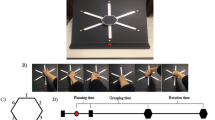Abstract
Fitts’ Law is commonly found to apply to motor tasks involving precise aiming movements. Children with cerebral palsy (CP) have severe difficulties in such tasks and it is unknown whether they obey Fitts’ Law despite their motor difficulties. If Fitts’ Law still does apply to these children, this would indicate that this law is extremely robust and that even performance of children with damaged central nervous systems can adhere to it. The integrity of motor control processes in spastic CP is usually tested in complex motor tasks, making it difficult to determine whether poor performance is due to a motor output deficit or to problems related to cognitive processes since both affect movement precision. In the present study a simple task was designed to evaluate Fitts’ Law. Tapping movements were evaluated in 22 children with congenital spastic hemiplegia (CSH) and 22 typically developing children. Targets (2.5 and 5 cm in width) were placed at distances of 10 and 20 cm from each other in order to provide Indices of Difficulty (ID) of 2–4 bits. Using this Fitts’ aiming task, prolonged reaction and movement time (MT) were found in the affected hand under all conditions in children with CSH as compared to controls. Like in the control group, MT in children with CSH was related to ID. The intercept ‘a’, corresponding to the time required to realize a tapping movement, was higher in the affected hand of the children in the CSH group. Although, the slope b (which reflects the sensitivity of the motor system to a change in difficulty of the task) and the reciprocal of slope (that represents the cognitive information processing capacity, expressed in bits/s) were similar in both groups. In conclusion, children with CSH obey Fitts’ Law despite very obvious limitations in fine motor control.





Similar content being viewed by others
References
Ashworth B (1964) Preliminary trial of carisoprodol in multiple sclerosis. Practitioner 192:540–542
Crossman ER, Goodeve PJ (1983) Feedback control of hand-movement and Fitts’ Law. Q J Exp Psychol A 35(Pt 2):251–278
De Jong WP, Hulstijn W, Kosterman BJM, Smits-Engelsman BCM (1995) Oasis: a new macro language for the experimental research of handwriting. In: Proceedings of the Seventh Handwriting Conference of the International Graphonomics Society, London Ontario. International Graphonomics Society, London Ontario
Duque J, Thonnard JL, Vandermeeren Y, Sebire G, Cosnard G, Olivier E (2003) Correlation between impaired dexterity and corticospinal tract dysgenesis in congenital hemiplegia. Brain 126:732–747
Ehrsson HH, Naito E, Geyer S, Amunts K, Zilles K, Forssberg H, Roland PE (2000) Simultaneous movements of upper and lower limbs are coordinated by motor representations that are shared by both limbs: a PET study. Eur J Neurosci 12:3385–3398
Eliasson AC, Gordon AM, Forssberg H (1995) Tactile control of isometric fingertip forces during grasping in children with cerebral palsy. Dev Med Child Neurol 37:72–84
Fitts PM (1954) The information capacity of the human motor system in controlling the amplitude of movement. J Exp Psychol 47:381–391
van Galen GP, de Jong WP (1995) Fitts’ law as the outcome of a dynamic noise filtering model of motor control. Hum Mov Sci 14:539–571
Gan KC, Hoffmann ER (1988) Sequential ballistic movement. Ergonomics 31:1421–1436
Gordon AM, Charles J, Duff SV (1999) Fingertip forces during object manipulation in children with hemiplegic cerebral palsy. II: bilateral coordination. Dev Med Child Neurol 41:176–185
Gump A, LeGare M, Hunt DL (2002) Application of Fitts’ law to individuals with cerebral palsy. Percept Mot Skills 94:883–895
Hagberg B, Hagberg G, Olow I (1993) The changing panorama of cerebral palsy in Sweden. VI. Prevalence and origin during the birth year period 1983–1986. Acta Paediatr 82:387–393
Horger MM (1990) The reliability of goniometric measurements of active and passive wrist motions. Am J Occup Ther 44:342–348
Keele SW, Hawkins HL (1982) Explorations of individual differences relevant to high level skill. J Mot Behav 14:3–23
Kuhtz-Buschbeck JP, Ehrsson HH, Forssberg H (2001) Human brain activity in the control of fine static precision grip forces: an fMRI study. Eur J Neurosci 14:382–390
LeGare M, Wolak C, Doyle B (1994) Stimulus-response compatibility in a small sample of cerebral palsied adults. Percept Mot Skills 79:1459–1474
Mutsaarts M, Steenbergen B, Bekkering H (2005) Anticipatory planning of movement sequences in hemiparetic cerebral palsy. Motor Control 9(4):439–458
Plamondon R, Alimi AM (1997) Speed/accuracy trade-offs in target-directed movements. Behav Brain Sci 20:279–303; discussion 303–249
Sanger TD, Kaiser J, Placek B (2005) Reaching movements in childhood dystonia contain signal-dependent noise. J Child Neurol 20:489–496
Smits-Engelsman BC, Rameckers EA, Duysens J (2004) Late developmental deficits in force control in children with hemiplegia. Neuroreport 15:1931–1935
Smits-Engelsman BC, Rameckers EA, Duysens J (2005) Muscle force generation and force control of finger movements in children with spastic hemiplegia during isometric tasks. Dev Med Child Neurol 47:337–342
Smits-Engelsman BC, Sugden D, Duysens J (2006) Developmental trends in speed accuracy trade-off in 6-10-year-old children performing rapid reciprocal and discrete aiming movements. Hum Mov Sci 25:37–49
Smits-Engelsman BC, Van Galen GP, Duysens J (2002) The breakdown of Fitts’ law in rapid, reciprocal aiming movements. Exp Brain Res 145:222–230
Thomas B, Eyssen M, Peeters R, Molenaers G, Van Hecke P, De Cock P, Sunaert S (2005) Quantitative diffusion tensor imaging in cerebral palsy due to periventricular white matter injury. Brain 128:2562–2577
Wolff PH, Cohen C, Drake C (1984) Impaired motor timing control in specific reading retardation. Neuropsychologia 22:587–600
Zancolli EA, Zancolli ER Jr (1981) Surgical management of the hemiplegic spastic hand in cerebral palsy. Surg Clin North Am 61:395–406
Author information
Authors and Affiliations
Corresponding author
Rights and permissions
About this article
Cite this article
Smits-Engelsman, B.C.M., Rameckers, E.A.A. & Duysens, J. Children with congenital spastic hemiplegia obey Fitts’ Law in a visually guided tapping task. Exp Brain Res 177, 431–439 (2007). https://doi.org/10.1007/s00221-006-0698-x
Received:
Accepted:
Published:
Issue Date:
DOI: https://doi.org/10.1007/s00221-006-0698-x




